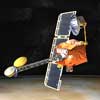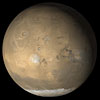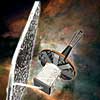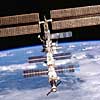|
Sunday:
October 14, 2001 | |
0140 GMT |
 |
Galileo approaches another close encounter with Io
NASA's durable Galileo spacecraft will skim close to the south pole of Jupiter's moon Io this week in search of new insight about that moon's volcanic surface and molten interior. The Monday night flyby is taking the spacecraft back inside the hazardous environment of Jupiter's intense radiation belts.
 FULL STORY FULL STORY
 |  |

|
 |
Lunar soil yields evidence of sun's dynamic workings
Soil collected on the moon nearly 30 years ago has helped researchers uncover new details about the workings of the sun. Physicists analyzed lunar soil samples for the presence of an element deposited on the moon's surface by the solar winds, a stream of particles constantly being ejected from the sun.
 FULL STORY FULL STORY
 |  |

|
 |
|
Saturday:
October 13, 2001 | |
0447 GMT |
 |
Andromeda's black hole not as cool as believed
Last year scientists using NASA's Chandra X-ray Observatory announced the discovery of an unusual source very near the nucleus of the Andromeda Galaxy, which astronomers associated with the supermassive black hole located at the center of M31. But a closer look has caused the story to change.
 FULL STORY FULL STORY
 |  |

|
 |
Odyssey nears Mars
Following Friday's final planned course correction, a three-second thruster firing, NASA's 2001 Mars Odyssey spacecraft is now on target to enter Martian orbit later on the evening of October 23.
 FULL STORY FULL STORY
 |  |

|
 |
Ulysses reaches the Sun's north pole today
For the second time in its 11-year lifetime, ESA's Ulysses spacecraft is about to fly over the Sun's north pole. Today, it will reach its highest north solar latitude (80 degrees north).
 FULL STORY FULL STORY
 |  |

|
 |
|
Friday:
October 12, 2001 | |
0309 GMT |
 |
Spacecraft track massive dust storm on Mars
Observations of the largest dust storm to hit the planet Mars in 30 years may shed new light on why such global dust storms form, scientists announced Thursday.
 FULL STORY FULL STORY
 |  |

|
 |
Ancient drainage basin became aquifer on Mars
An enormous ancient drainage basin and aquifer system lies hidden and deformed in one of the most geologically dynamic landscapes on Mars, scientists conclude from a comprehensive, more than 10-year study.
 FULL STORY FULL STORY
 |  |

|
 |
NASA launches 'Flags for Heroes and Families'
In a unique extension of a tradition that dates back to the beginning of human space flight, NASA Administrator Daniel S. Goldin announced Thursday that the next mission of Space Shuttle Endeavour will honor the victims of last
month's terrorist attacks in New York, Washington and Pennsylvania.
 FULL STORY FULL STORY
 |  |

|
 |
|
Thursday:
October 11, 2001 | |
0647 GMT |
 |
Atlas 2AS rocket propels top-secret cargo into orbit
While America strikes back against terrorism half-way around the world, a surge of three previously-planned U.S. national security satellite launches in one month's time was completed successfully Wednesday night as a Lockheed Martin Atlas rocket soared into space from Cape Canaveral, Florida.
 FULL STORY FULL STORY
 MISSION STATUS CENTER MISSION STATUS CENTER
 DETAILED LAUNCH TIMELINE DETAILED LAUNCH TIMELINE
 LAUNCH GROUND TRACK LAUNCH GROUND TRACK
 ROCKET FACT SHEET ROCKET FACT SHEET
 |  |

|
 |

Video coverage for subscribers only:

 VIDEO: LAUNCH TEAM POLLED FOR FINAL "GO" QT or RV VIDEO: LAUNCH TEAM POLLED FOR FINAL "GO" QT or RV
 VIDEO: ATLAS BLASTS OFF FROM CAPE CANAVERAL QT or RV VIDEO: ATLAS BLASTS OFF FROM CAPE CANAVERAL QT or RV
 VIDEO: THIS ATLAS ROCKET NICKNAMED "AQUILA" QT or RV VIDEO: THIS ATLAS ROCKET NICKNAMED "AQUILA" QT or RV
 VIDEO: PAYLOAD DEPLOYMENT CONFIRMED QT or RV VIDEO: PAYLOAD DEPLOYMENT CONFIRMED QT or RV
 MORE: COMPLETE SFN+ VIDEO INDEX MORE: COMPLETE SFN+ VIDEO INDEX

|
Toxic compound in space signals starbirth
Centuries ago it was commonly believed that comets carried disease in their tails. But these old beliefs were not completely wrong: comet tails do contain an extremely poisonous chemical compound - hydrogen cyanide. Now a team of astronomers have discovered that this poison can help them to understand the birth of massive stars.
 FULL STORY FULL STORY
 |  |

|
 |
New positioning technique saves satellite, maybe more
A European Space Agency environmental satellite has been saved after all of the craft's critical positioning gyroscopes stopped functioning. The rescue was pulled off by using the ingenuity of engineers and the capabilities of the other instruments aboard the satellite.
 FULL STORY FULL STORY
 |  |

|
 |
DAILY BRIEFING Other stories making news today
|
 |
NASA-funded physicist shares Nobel Prize -- The 2001 Nobel Prize for physics has been awarded to three scientists, including a Massachusetts Institute of Technology physicist whose NASA-funded research uses ultra-cold atoms that form a new type of matter.
|
 |
|
Wednesday:
October 10, 2001 | |
0001 GMT |
 |
Atlas to launch today
A Lockheed Martin Atlas rocket remains scheduled for blastoff this evening from Cape Canaveral carrying a clandestine cargo for the National Reconnaissance Office -- the U.S. government's spy satellite agency.
 MISSION STATUS CENTER - updates MISSION STATUS CENTER - updates
 DETAILED LAUNCH TIMELINE DETAILED LAUNCH TIMELINE
 LAUNCH GROUND TRACK LAUNCH GROUND TRACK
 ROCKET FACT SHEET ROCKET FACT SHEET
 |  |

|
 |
Delta 4 pad dedicated, first customer confirmed
Boeing dedicated its new launch pad at Cape Canaveral's Complex 37 today where Delta 4 rockets will lift off from starting next April. A company official, meanwhile, confirmed that the inaugural launch will carry a Eutelsat commercial telecommunications satellite, which had been rumored for some time.
 BOEING RELEASE ON DEDICATION BOEING RELEASE ON DEDICATION
 |  |

|
 |
Innovative low-risk design proposed for NASA's NGST
A team led by Lockheed Martin has submitted a proposal to NASA for the Next Generation Space Telescope, a new space observatory to observe the first stars and galaxies formed in the Universe. The team's design for the
observatory includes a lightweight 6-meter-class deployable mirror.
 FULL STORY FULL STORY
 |  |

|
 |
NASA radar gives fresh look at Alaska's unique terrain
A NASA mission to study Alaska's unique terrain is providing scientists with their first detailed look at the changing topography of one of Earth's most active volcanic regions.
 FULL STORY FULL STORY
 |  |

|
 |
DAILY BRIEFING Other stories making news today
|
 |
New space school opens doors and minds -- The military has been teaching air tactics for 80 years. The Air Force's newest school is continuing that long heritage, helping to bridge the gap between air and space.
|
 |
|
Tuesday:
October 9, 2001 | |
0440 GMT |
 |
Spacewalk outfits space station Alpha's new module
The two Russian cosmonauts of the Expedition Three crew living on the international space station stepped outside Monday for a successful spacewalk to outfit the newly arrived Pirs docking module.
 MISSION STATUS CENTER MISSION STATUS CENTER
 |  |

|
 |

Video coverage for subscribers only:

 VIDEO: FLOATING OUT OF PIRS MODULE QT or RV VIDEO: FLOATING OUT OF PIRS MODULE QT or RV
 VIDEO: INSTALLING BASE OF CARGO CRANE QT or RV VIDEO: INSTALLING BASE OF CARGO CRANE QT or RV
 VIDEO: A SPACEWALK ROOKIE QT or RV VIDEO: A SPACEWALK ROOKIE QT or RV
 VIDEO: BLANKET TOSSED INTO SPACE QT or RV VIDEO: BLANKET TOSSED INTO SPACE QT or RV
 MORE: COMPLETE SFN+ VIDEO INDEX MORE: COMPLETE SFN+ VIDEO INDEX

|
Ulysses sees the Sun begin to quieten down
Order is returning to the solar wind as the Sun begins to shake off the chaos that has characterised its behaviour during the recent peak in its 11-year activity cycle.
 FULL STORY FULL STORY
 |  |

|
 |
Getting a close-up view of planetary birth
Early next year, scientists hope to gain insight into conditions that precede planet birth by deploying a powerful new instrument: the Keck Interferometer. The twin Keck telescopes are the world's largest telescopes for optical and near-infrared astronomy.
 FULL STORY FULL STORY
 |  |

|
 |
|
Monday:
October 8, 2001 | |
0319 GMT |
 |
Alpha spacewalk today
The two Russian cosmonauts of the Expedition Three crew living on the international space station will step outside today for a spacewalk to perform outfitting of the newly arrived Pirs docking module. The excursion begins at 1400 GMT (10 a.m. EDT).
 MISSION STATUS CENTER MISSION STATUS CENTER
 STATION SCIENCE REPORT STATION SCIENCE REPORT
 |  |

|
 |
Atlas rocket to launch another NRO satellite
A classified cargo believed to be some sort of communications spacecraft will be propelled into geosynchronous transfer orbit this week by a Lockheed Martin Atlas rocket.
 MISSION STATUS CENTER MISSION STATUS CENTER
 DETAILED LAUNCH TIMELINE DETAILED LAUNCH TIMELINE
 LAUNCH GROUND TRACK LAUNCH GROUND TRACK
 ROCKET FACT SHEET ROCKET FACT SHEET
 |  |

|
 |


 The Hubble Space Telescope's majestic view of the Eskimo Nebula. This spectacular poster is available now from the Astronomy Now Store.
The Hubble Space Telescope's majestic view of the Eskimo Nebula. This spectacular poster is available now from the Astronomy Now Store.